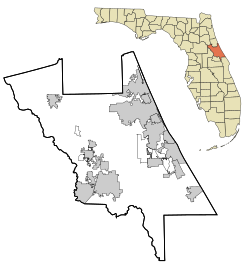This article includes a list of general references, but it lacks sufficient corresponding inline citations .(February 2013) |
Seminole Rest | |
 Instone House, in the Seminole Rest Park | |
| Location | 207 River Road Oak Hill, Florida |
|---|---|
| Coordinates | 28°52′11″N80°50′15″W / 28.86972°N 80.83750°W |
| NRHP reference No. | 97000231 [1] |
| Added to NRHP | March 19, 1997 |
This article lacks inline citations besides NRIS, a database which provides minimal and sometimes ambiguous information.(January 2014) |
Wikimedia Commons has media related to Seminole Rest .
Seminole Rest (also known as the Snyder Hill or Oak Hill or Live Oak Hill) is a historic site in Oak Hill, Florida, United States. It is located east of State Road 5, on the western shore of Mosquito Lagoon, and is part of the Canaveral National Seashore. On March 19, 1997, it was added to the U.S. National Register of Historic Places.
